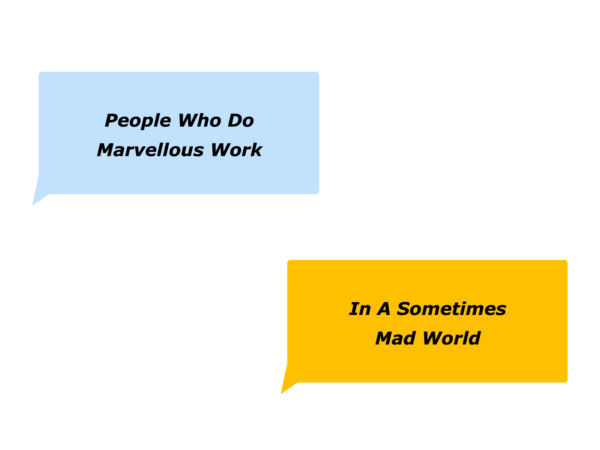
Some people aim to do marvellous work when it seems that parts of the world are going mad. They may work as medics, artists, scientists or in other roles. They often do work that cares for people or the planet.
Some cocoon themselves by creating a space they can control. They may do this when writing a book, doing a project, teaching a class, inventing a product or doing something else that helps to shape a positive future.
Some are prepared to immerse themselves in tough challenges. They may care for the needy, treat the victims of violence, mediate in conflicts or do other things to provide practical hope.
Some aim to show people a positive way of living or working. Such people follow the together approach rather than the tribal approach. They show how people can build on what they have in common, combine their strengths and achieve success.
Such people often build on their strengths. Bearing in mind what they can control, they aim to set specific goals, do superb work and achieve successes. Why? One person expressed this in the following way.
“I want to stay sane and do work that helps other people in a sometimes insane world.”
Different people choose different ways to do such work. You may aim to encourage people, create inspiring classroom, run a website that helps people recovering from illness or do other things that lifts people’s spirits.
The following section looks at two people who have done marvellous work that has encouraged people in different ways.
Mihaly Csikszentmihalyi
– His Work On Flow
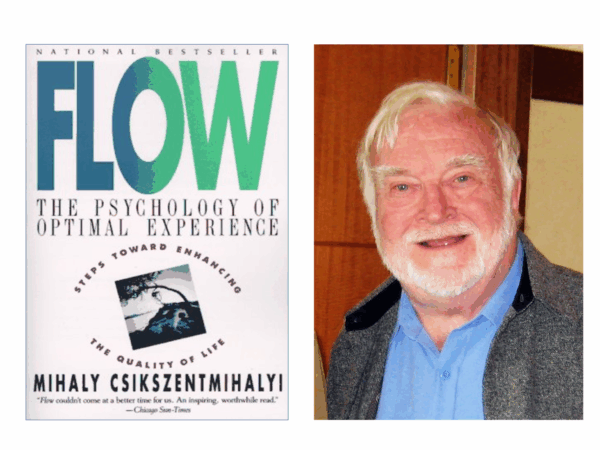
Mihaly’s work stemmed from seeing the devastation caused by the Second World War. He resolved to study humanity at its best and show people another way of living. This eventually led to him publishing his book Flow.
Flow experiences are those in which you become completely absorbed and time goes away. You start by doing something stimulating – be it writing, skiing, solving a problem, tackling a challenge or whatever.
You set a clear goal, employ your skills and stretch yourself to achieve success. Then something odd happens. Mihaly described this in the following way.
Your awareness of self disappears but, after completing the task, your sense of self emerges even stronger.
You flow, focus, finish and, as a by-product, find fulfilment. Mihaly’s work shows how people can find and follow certain principles to create flow in the future.
Background And Philosophy
Mihaly was born in Rijecka, Croatia, in 1934. His family was Hungarian, and his father Alfred, a diplomat, had been posted to Italy. Living in cities such as Rome and Florence exposed Mihaly to different cultures and he became fluent in Hungarian, Italian and German.
Despite being a child, he was interned in Italy for a while and tried to make sense of events. Interviewed years later by Dava Sobel for Omni Magazine, he described these in the following way.
As a child in World War 2 Europe, I was dismayed to find that grown-ups had no idea what was going on and were helpless to extricate themselves from the mess they had created.
I resolved to figure out how one could live a better life. I tried many things, such as art, fiction, philosophy and working in youth organisations.
I discovered psychology through the writings of C.J. Jung, and thought that perhaps this was the best way to understand behaviour and history.
I can’t say I have, but in the process I learned a lot and had a good time.
Choosing to study psychology at university level, he found the most attractive courses were in America. He applied to the University of Chicago and, despite speaking little English, was accepted.
He improved his English by reading comic books, but a greater difficulty was his parents losing their life savings to a fraudster employed in their restaurant. Mihaly arrived in Chicago in 1956 with little more than a dollar in his pocket.
He did well at university and went on to study for a Masters. Explaining his chosen field of study, Mihaly described this in the following way to Elizabeth Debold of Enlightenment Magazine.
I did my doctoral dissertation on young students at the Chicago Art Institute.
One thing that I noticed – and I knew also from my own experience – is that when they started painting, they almost fell into a trance. They didn’t seem to notice anything, and they just moved as if they were possessed by something inside themselves.
When they finished a painting, they would look at it, and they’d feel good for about five or ten minutes. Then they’d put the painting away and not look at it much after that. What became important was the next canvas …
So I tried to understand what psychologists have written about this kind of thing, this state of complete involvement.
Mihaly moved on to studying chess players, rock climbers, musicians and basketball players. He asked them to describe what happened when what they were doing was really going well.
Despite coming from different fields, people reported similar experiences. Explaining this in an interview with Sarah Trevelyan, Mihaly described it in the following way.
Many of the interviewees described their feeling as ‘being carried away by a force greater than myself,’ or ‘being in a current,’ or ‘being in flow.’ I chose the last of these analogies as being the most simple.
He then went on to write many articles and books on the concept of flow. These including the following.
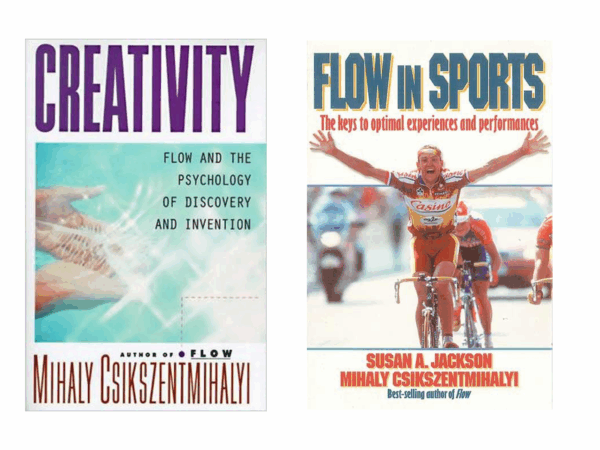
Principles
Mihaly’s work focuses on people experiencing being fully alive. Here are some of the principles it highlights.
People from all walks of life
can experience a state of flow
Beginning by asking artists, musicians and surgeons to describe their flow experiences, Mihaly then interviewed people from all walks in life. These have included factory workers in Chicago, farmers in Italy, teenagers in Tokyo and paraplegics recovering from accidents.
He and his colleagues have talked with tens of thousands of people from all around the world and similar themes emerged. He described this in the following way.
Women who weave tapestries in the highlands of Borneo, meditating monks in Europe, also Catholic Dominican monks, and so forth. They all said these same things. So flow seems to be a phenomenological state that is the same across cultures.
People follow certain principles
to achieve a state of flow
So what do people do right to achieve flow? Mihaly identified certain principles they follow. They pursue these as individuals, but also sometimes as a team. He writes:
Surgeons say that during a difficult operation they have the sensation that the entire operating team is a single organism, moved by the same purpose.
They describe it as a ‘ballet’ in which the individual is subordinated to the group performance, and all involved share in a feeling of harmony and power.
This involves taking certain steps – whether you are working as an individual or as part of a team.
These include: tackling a stimulating task – or one you make stimulating – setting a clear goal, being fully concentrated, getting feedback, being creative, stretching yourself and, hopefully, achieving your picture of success.
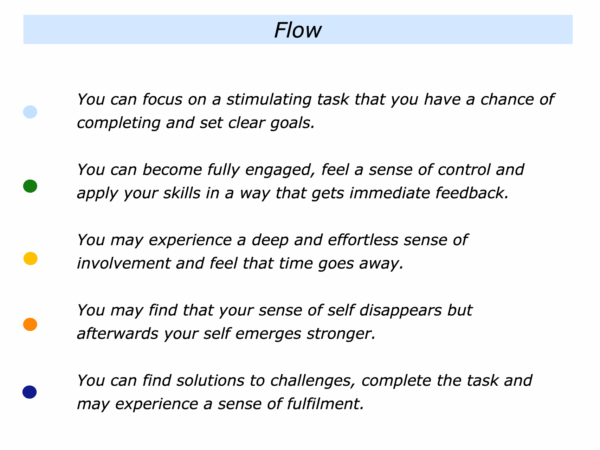
People can follow these principles in
the future to achieve a sense of flow
Mihaly once invited an 84-year-old man to describe his flow experiences. The man recalled a time when, as 24-year-old, he was playing polo.
After identifying what the man did right at that time, Mihaly explained that he could follow similar principles to experience flow in other activities. The man had not previously made the connection. He thought the experience was exclusive to polo.
Making up for lost time, he immediately threw himself into new activities and, following the principles, enjoyed a sense of flow. Mihaly described this in the following way in his book Flow.
What I discovered was that happiness is not something that just happens.
We have all experienced times when, instead of being buffeted by anonymous forces, we do feel in control of our actions, masters of our own fate.
On the rare occasions that it happens, we feel a sense of exhilaration, a deep sense of enjoyment that is long cherished and that becomes a landmark in memory for what life should be like.
The best moments usually occur when a person’s body or mind is stretched to its limits in a voluntary effort to accomplish something difficult and worthwhile.
Optimal experience is therefore something that we make happen.
Mihaly describes his life’s work as the effort: “To study what makes people truly happy.” The emphasis is on the word ‘truly’.
He believes true happiness calls for being part of something that goes beyond ourselves and, hopefully, builds a better world. He described this in the following way.
Each of us has a picture, however vague, of what we would like to accomplish before we die.
How close we get to attaining this goal becomes the measure for the quality of our lives.
If it remains beyond reach, we grow resentful or resigned; if it is at least in part achieved, we experience a sense of happiness and satisfaction.
Pauline Cutting – Her
Work Caring For People

Pauline has dedicated her life to caring for people. During the 1980s she worked as a war zone doctor in Lebanon. She described this in her 1988 book Children Of The Siege.
She felt nervous but excited when landing at Beirut airport in December 1985. She was about to embark on working as a surgeon for MAP (Medical Aid For Palestinians).
Turning off the airport road into the Bourj al Barjneh camp, she was shocked at the poverty and squalor. She was met by Barbara, a friendly woman who laughed a lot.
Local custom decreed that women shouldn’t behave in such a fashion. So Barbara was learning the Arabic for:
”I’m sorry I laugh so much.”
Life in Beirut was the proverbial hell on Earth where people coped with daily tragedies. Pauline describes how a 15-year-old boy was rushed to Haifa hospital by stretcher-bearers.
Shot in the head by a handgun, he had a large gaping wound which exposed his brain. The medical staff decided to transfer him to the American University Hospital which had special facilities for neurosurgery.
The Lebanese Red Cross came with an ambulance and I went with him to hospital. The twenty minute journey was a nightmare. Driving at high speed with the sirens blazing, once smashing a bollard.
This meant we were thrown around the back of the ambulance. The skin was taken off my knees as I slid along the floor. The injured boy, Jihad, was sick and had to clean out his mouth with my hand.
One month later Pauline was happy to report that Jihad was making good progress. One year later, however, she found herself in great danger, trapped in the camp in the midst of a 163 day siege.
Cut off from the world, the medical staff continued to treat the wounded, whilst everybody suffered from fear, head lice and starvation. Pauline’s own weight went down to 43 kilos and, when somebody offered her a spoonful of cooked dog, she accepted.
The misery she was experiencing for the first time, she wrote, was the daily lot of these people. They had endured it for the past 40 years and it was unjust.
Starvation was not the only danger. After Pauline had co-written a declaration asking for help from the outside world, Amal militiamen demanded to know who was working in the camp.
When Pauline’s name was mentioned, they said:
“Yes, we know about her. We are going to cut her into pieces.”
Forty years later, in 2021, she recalled what happened later in an interview she did for the North Wales Live website. This described how Pauline’s work and communication with the outside world helped the situation.
No one believed what was going on – until Dr Cutting stepped and spoke up on behalf of the residents, bringing the crisis to the attention of the wider world.“A lot of people were dying,” she recalled. “We were all afraid.
“Someone fixed up a radio antenna to an old car battery so I could speak to journalists and explain how desperate things were.
“In some way it was those journalists who saved my life.”
Famously, she told those listening:
“We will stay with the people of the camp until the danger is over.
“We will remain with them – to live or die with them.”
The quote reverberated around the world.
After 18 months of hell, the siege was lifted and Dr Cutting was able to return home to Amsterdam with Dutch husband Ben Alofs. Undeterred, the pair would return to the Gaza Strip for a six-month stint while Ben awaited entry to medical college.
Pauline then spent a decade the Netherlands before returning to the UK to work in the emergency department in Bangor. Her ongoing dedication to caring for people led to her being awarded an OBE.
There are many ways to do fine work. Some people build on their strengths and do marvellous work in a sometimes mad world. They try to encourage other people in their life and work.
Let’s return to your own life. Can you think of a specific activity where you may want to build on your strengths and follow elements of this approach? How can you do this in your own way?
If you wish, try tackling the exercise on this theme. This invites you to complete the following sentences.


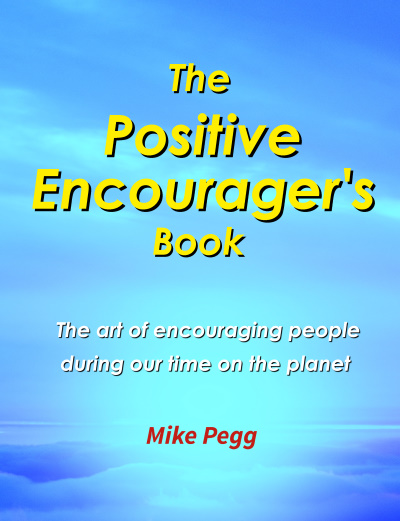
Leave a Reply